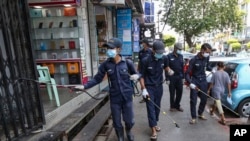Health experts say the low Covid-19 case numbers some Southeast Asian countries are reporting — some still in the single digits — have much more to do with limited testing than reality. They warn that faulty figures may breed a false sense of security and help the virus causing the deadly disease to spread.
Laos and Myanmar, which both border China, where the global coronavirus pandemic sprouted late last year, were still reporting zero cases early last week. Laos has since confirmed six cases as of Saturday. Myanmar, which borders China for more than 2,000 kilometers, has confirmed eight.
Cambodia and Vietnam, which also share close cultural and commercial ties with China, have reported 104 and 169 cases respectively, more than Laos or Myanmar but still on the low end.
"That's just a consequence of very limited testing capacity and weak surveillance, and that's just a reality," said Mark Simmerman, a private health consultant based in Thailand and a former epidemiologist for the U.S. Centers for Disease Control and Prevention who worked on the region's response to the SARS outbreak in 2003.
"These very small numbers are unrealistic," he said.
Indonesia, Malaysia and Thailand, meanwhile, each now have confirmed cases into the thousands, although even there, some health experts are complaining. In Indonesia, national Red Cross chief Jusuf Kalla has said there were likely far more infections than the country was reporting, given low levels of testing.
As of early last week, Laos had tested only 131 people. Myanmar, a country of nearly 54 million, had tested some 300. South Korea, by contrast, with about as many people as Myanmar, has tested hundreds of thousands and found more than 9,000 coronavirus cases.
"It's how hard are you looking, and how aggressively are you testing, and how thoroughly are you following up on every single case, all of their contacts," said Simmerman.
Some Southeast Asian countries were slow to acknowledge the risks.
In mid-March a spokesman for Myanmar's government was still crediting the "lifestyle and diet" of locals for the lack of confirmed coronavirus cases. In mid-February, before Indonesia reported its first case, the health minister praised his compatriots' penchant for prayer for keeping the virus at bay. Cambodia was welcoming flights from China well into February, long after many other countries had banned them for fear of importing the infection.
Even though the countries now have some social distancing measures in place — canceling public events, limiting crowd sizes or restricting travel, experts say low confirmed case counts resulting from limited testing will make it harder for those measures to stick.
"It delays a sense of urgency, it removes it, and any sense of needing to comply or needing to change one's behaviors, stop traveling, stop interacting in certain ways. Those don't take hold until people genuinely understand the situation, and part of it is the lab cases, case counts, at least early in the course of this," said Simmerman.
Jeremy Lim, co-director of global health at the National University of Singapore's Saw Swee Hock School of Public Health, agreed.
"Social distancing is the most effective public health intervention everyone can take, together with hand washing. So [in] countries that are lulled into a false sense of security, the citizens would be ... less willing to actively socially distance, and hence there will be risk of spread," he said.
"And because spread is exponential, because the R0 [the average number of people who will catch the virus from an infected person] is believed to be between two and three, it just means ... that people that don't isolate, that countries that don't test, have a higher risk of widespread transmission in the community."
Like Simmerman, Lim also believes the lowest Covid-19 tallies some Southeast Asian countries are reporting do not reflect the actual number of infections.
Those countries, perhaps not by coincidence, also have some of the most repressive governments and threadbare public health care systems in the region. They struggle to meet the basic medical needs of their people even in the best of times and may fear overwhelming their hospitals and clinics if they catch most coronavirus cases.
"If a country can do very little about it, meaning that it doesn't have the test kits, it doesn't have the intensive care facilities, ventilators, then capturing accurate data may not be the highest priority since not very much can be done about it," said Lim.
Matthew Griffith, an epidemiologist with the World Health Organization's regional office in Manila, which does not cover Myanmar, said Laos was doing the best it could with what it had. Whether that's enough to capture the true scale of infections is another matter.
"To be honest, just about no country has enough tests," Griffith said, including rich ones like the U.S.
"It's quite difficult to detect everywhere," he said of the virus. "So I think that under-detection of disease is not a problem [only] in Laos but is a problem globally."
With no telling how long the pandemic will last, Griffith added, many countries are also rationing the testing supplies they have; few can afford the widespread testing seen in South Korea. He said the border closures and flight bans Southeast Asian countries are imposing to keep from importing more cases will also make it harder to resupply the poorest of them.
All agreed that the better off should be doing more to get the poorest countries the tests and other supplies they need.
"If we don't want the lowest-resourced countries to continue to be reservoirs for Covid-19, for the coronavirus, then the richer and better-resourced countries really need to step up," said Lim.




